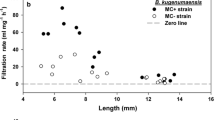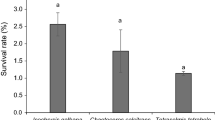Abstract
Increasing temperatures in aquatic ecosystems have resulted in changes in the proliferation patterns and persistence of cyanobacteria, particularly Microcystis sp.. In temperate lakes, large-sized herbivores such as Daphnia magna are used to control cyanobacterial blooms. The cladoceran, Simocephalus mixtus and the amphipod, Hyalella azteca are common in tropical and sub-tropical aquatic systems. Since both species are generalist feeders, we tested their ability to consume uni-cellular Microcystis sp. and Chlorella at different temperatures. Feeding rates and filtration rates at different temperatures (20, 25 and 30 °C) were quantified on diets of Chlorella vulgaris and Microcystis sp.; each diet separately at different concentrations (0.2, 0.5, 1.0 and 2.0 × 106 cell mL−1). Both the crustaceans were able to consume C. vulgaris and Microcystis sp. although at different rates depending on the food concentration and temperature. At 25 °C and a Microcystis sp. concentration of 2.0 × 106 cells mL−1, H. azteca fed up to 60 × 104 cells ind−1 h−1 of Microcystis sp. which was even greater than its feeding rate on C. vulgaris. Simocephalus was able to consume Microcystis sp. although at significantly lower rates as compared to C. vulgaris. Our experiments show that H. azteca can feed well on Microcystis sp.. Combined with control in fish predation pressure, both crustacean species could be used in top-down control, but further investigation on a large scale with these organisms is necessary to propose new alternatives.




Similar content being viewed by others
References
Alcocer J, Escobar-Briones E, Peralta L, Alvarez F (2002) Population structure of the macrobenthic amphipod Hyalella azteca Saussure (Crustacea: Peracarida) on the littoral zone of six crater lakes. In: Escobar-Briones E, Alvarez F (eds) Modern approaches to the study of crustacea. Springer, Boston, pp 111–115
Borowitzka MA, Borowitzka LJ (eds) (1988) Micro-algal biotechnology. Cambridge University, Cambrige
Brito D, Milani N, Pereira G (2006) Tasa de filtración e ingestión de Simocephalus vetulus (Müller, 1776) (Crustacea: Cladocera) alimentado con Selenastrum capricornutum Printz, 1914 y Chlorella vulgaris Beijerinck, 1890. Interciencia 31:753–757
Burns CW (1968) The relationship between body size of filter feeding cladocera and the maximum size of particle ingested. Limnol Oceanogr 13:675–678
Burns CW (1969) Relation between filtering rate, temperature, and body size in four species of Daphnia. Limnol Oceanogr 14:693–700
Camacho FA, Thacker RW (2006) Amphipod herbivory on the freshwater cyanobacterium Lyngbya wollei: chemical stimulants and morphological defenses. Limnol Oceanogr 51:1870–1875
Camacho FA, Thacker RW (2013) Predator cues alter habitat use by amphipod Hyalella azteca (Saussure). Freshw Sci 32:1148–1154
Cardinale BJ, Brady VJ, Burton TM (1998) Changes in the abundance and diversity of coastal wetland fauna from the open water/macrophyte edge towards shore. Wetlands Ecol Manag 6:59–68
Carpenter SR, Kitchell KL (1993) The trophic cascade in lakes. Cambridge University, Cambridge
Chaparro-Herrera DJ, Nandini S, Sarma SSS (2013) Effect of water quality on the feeding ecology of the axolotl Ambystoma mexicanum. J Limnol 72:555–563
Chorus I, Bartram J (eds) (1999) Toxic cyanobacteria in water: a guide to their public health consequences, monitoring and management. E & FN Spon, New York
Corline NJ, Sommer T, Jeffres CA, Katz J (2017) Zooplankton ecology and trophic resources for rearing native fish on an agricultural floodplain in the Yolo Bypass California. USA Wetlands Ecol Manag 25(5):533–545
Dias JD, Miracle MR, Bonecker CC (2017) Do water levels control zooplankton secondary production in Neotropical floodplain lakes? Fundam Appl Limnol 190:49–62
Environmental Protection Agency (EPA) (2017) Cases and prevention. http://www.tandfonline.com/action/authorSubmission?show=instructions&journalCode=ulrm20. Accessed 13 Aug 2017
Fernandez R, Nandini S, Sarma SSS (2012) A comparative study on the ability of tropical micro-crustaceans to feed and grow on cyanobacterial diets. J Plankton Res 34:719–731
Figueroa-Sánchez MA, Nandini S, Sarma SSS (2014) Zooplankton community structure in the presence of low levels of cyanotoxins: a case study in a high altitude tropical reservoir (Valle de Bravo, Mexico). J Limnol 73:157–166
Gayosso-Morales MA, Nandini S, Mártinez-Jeronimo FF, Sarma SSS (2017) Effect of organic and inorganic turbidity on the zooplankton community structure of a shallow waterbody in Central Mexico (Lake Xochimilco, Mexico). J Environ Biol 38:1183–1196
Ger KA, Hansson LA, Lürling M (2014) Understanding cyanobacteria–zooplankton interactions in a more eutrophic world. Freshw Biol 59:1783–1798
Ghadouani A, Pinel-Alloul B, Prepas EE (2003) Effects of experimentally induced cyanobacterial blooms on crustacean zooplankton communities. Freshw Biol 48:363–381
Gillooly FJ, Charnow LE, Wests BG, Savage MV, Brown JH (2002) Effects of size and temperature on developmental time. Nature 417:70–73
Gliwicz ZM (1990) Why do the cladocerans fail to control algal bloom? Hydrobiologia 200(201):83–97
Gulati RD (1990) Structural and grazing responses of zooplankton community to biomanipulation of some Dutch water bodies. Hydrobiologia 200:99–118
Hall DJ, Threlkeld ST, Burns CW, Crowley PH (1976) The size-efficiency hypothesis and the size structure of zooplankton communities. Ann Rev Ecol Syst 7:177–208
Heugens EHW, Tokkie LTB, Kraak MHS, Hendriks AJ, Van Straalen NM, Admiraal W (2006) Population growth of Daphnia magna under multiple stress conditions: join effects of temperature, food and cadmium. Environ Toxicol Chem 25:1399–1407
Iglesias C, Mazzeo N, Meerhoff M, Lacerot G, Clemente JM, Scasso F, Kruk C, Goyenola G, García-Alonso J, Amsinck SL et al (2011) High predation is of key importance for dominance of small-bodied zooplankton in warm shallow lakes: evidence from lakes, fish enclosures and surface sediments. Hydrobiologia 667:133–147
Jeppesen E, Meerhoff M, Jacobsen BA, Hansen RS, Søndegaard M, Jensen JP, Lauridsen TL, Mazzeo N, Branco CWC (2007) Restoration of shallow lakes by nutrient control and biomanipulation-the successful strategy varies with lake size and climate. Hydrobiologia 581:269–285
Jeppesen E, Meerhoff M, Holmgren K, González-Bergonzoni I, Teixeira-De Mello F, Decleck SAJ, De Meester L, Søndergaard M, Lauridsen TL, Bjerring R et al (2010) Impacts of climate warming on lake fish community structure and potential effects on ecosystem function. Hydrobiologia 646:73–90
Kasprzak P, Benndorf J, Gonsiorczyk T, Koschel R, Krienitz L, Mehner T, Hulsmann S, Schultz H, Wagner A (2007) Reduction of nutrient loading and biomanipulation as tools in water quality management: long-term observations on Bauzen reservoir and Feldberger Haussee (Germany). Lake Reserv Manag 23:410–427
Kiørboe T (2011) How zooplankton feed: mechanisms, traits and trade-offs. Biol Rev 86:311–339
Komarék J, Komárkova-Legnerová J (2002) Contribution to the knowledge of planktic cyanoprokaryotes from central Mexico. Preslia Praha 74:207–233
Kosten S, Huszar V, Bécares E, Costa L, Van Donk E, Hansson LA, Jeppessn E, Kruk C, Lacerot G, Mazzeo N et al (2012) Warmer climate boosts cyanobacterial dominance in shallow lakes. Glob Change Biol 18:118–126
Li Y, Xie P, Zhang J, Tao M, Deng X (2017) Effects of filter-feeding planktivorous fish and cyanobacteria on structuring the zooplankton community in the eastern plain lakes of China. Ecol Eng 99:238–245
Loiterton B, Sundbom M, Vrede T (2004) Separating physical and physiological effects of temperature on zooplankton feeding rate. Aquat Sci 66:123–129
Lürling M, Verschoor AM (2003) F0-spectra of chlorophyll fluorescence for the determination of zooplankton grazing. Hydrobiologia 491:145–157
MacIsaac JH, Hebert NPN, Schwartz SS (1985) Inter- and intraspecific variation in acute thermal tolerance of Daphnia. Physiol Zool 58:350–355
Mara D (2003) Domestic wastewater treatment in developing countries. Earthscan, London
Marmen S, Aharonovich D, Grossowicz M, Blank L, Yacobi YZ, Sher JD (2016) Distribution and habitat specificity of potentially-toxic Microcystis sp. across climate, land and water use gradients. Front Microbiol 7:1–14
McMahon JW (1965) Some physical factors influencing the feeding behavior of Daphnia magna Straus. Can J Zool 43:603–611
Monakov AV (2003) Feeding of freshwater invertebrates. Kenobi, Ghent
Moreira C, Vasconcelos V, Antunes A (2013) Phylogeny and biography of cyanobacteria and their produced toxins. Mar Drugs 11:4350–4369
Moss B (2018) Ecology of freshwater: earth’s bloodstream. John Wiley & Sons Ltd, Chichester
Mur LR, Olav MS, Hans U (1999) Cyanobacteria in the environment. In: Chorus I, Bartram J (eds) Toxic cyanobacteria in water: a guide to their public health consequences, monitoring and management. E & FN Spon, New York, pp 253–255
Nandini S, Rao TR (1998) Somatic and population growth in selected cladoceran and rotifer species offered the cyanobacterium Microcystis aeruginosa as food. Aquat Ecol 31:283–298
Nandini S, Ramírez-García P, Sarma SSS (2016) Water quality indicators in Lake Xochimilco, Mexico: zooplankton and Vibrio cholera. J Limnology 75:91–100
Nelson WG (1979) Experimental studies of selective predation on amphipods: consequences for amphipod distribution and abundance. J Exp Mar Biol Ecol 38:225–245
Panov VE, McQueen DJ (1998) Effects of temperature on individual growth rate and body size of freshwater amphipod. Can J Zool 76:1107–1116
Pérez-Morales A, Sarma SSS, Nandini S (2014) Feeding and filtration rates of zooplankton (rotifers and cladocerans) fed toxic cyanobacterium (Microcystis aeruginosa). J Environ Biol 35:1013–1020
Platvoet D, Dick JTA, Konijnendijk N, Van del Velde G (2006) Feeding on micro-algae in the invasive Ponto-Caspian amphipod Dikerogammarus villosus (Sowinsky, 1894). Aquat Ecol 40:237–245
Richardson AJ (2008) In hot water: zooplankton and climate change. ICES J Mar Sci 65:279–295
Rigler FH (1971) Feeding rates. Zooplankton. In: Downing JD, Rigler FH (eds) A manual on methods for the assessment of secondary productivity in fresh waters. Blackwell, Oxford
Sinha R, Peason LA, Davis TW, Burford MA, Orr PT, Neilan BA (2012) Increased incidence of Cylindrospermopsis raciborskii in temperate zones—is climate change responsible? Water Res 46:1408–1419
Sushchenya LM (1975) Kolichestvennye zakonomernosti pitaniya rakoobraznykh (Quiantitative regularities of crustacean feeding). In: Monakov AV (ed) Feeding of freshwater invertebrates. Kenobi, Ghent, pp 133–174
Venthuis M, De Senerpont Domis LN, Frenken T, Stephan S, Kazanjian G, Aben R, Hilt S, Kosten S, Van Donk E, Van de Waal DB (2017) Warming advances top-down control and reduces producer biomass in a freshwater plankton community. Ecosphere 8:1–e01651
Von Elert E, Wolffrom T (2001) Supplementation of cyanobacterial food with polyunsaturated fatty acids does not improve growth of Daphnia. Limnol Oceanogr 46:1552–1558
Weber CI (ed) (1993) Methods for measuring the acute toxicity of effluents and receiving waters to freshwater and marine organisms. EPA, Cincinnati
Whitton BA, Potts M (2000) The ecology of cyanobacteria: their diversity in time and space. In: Whitton BA, Potts M (eds) Introduction to the cyanobacteria. Springer, Netherlands, pp 1–11
Yin XW, Liu PF, Zhu SS, Chen XX (2010) Food selectivity of the herbivore Daphnia magna (Cladocera) and its impact on competition outcome between two freshwater green algae. Hydrobiologia 655:15–23
Zhang J, Xie P, Tao M, Guo L, Chen J, Li L, Zhang XZ, Zhang L (2013) The impact of fish predation and cyanobacteria on zooplankton size structure in 96 Subtropical lakes. PLoS ONE 4:e76378
Acknowledgements
M.A.F.S. thanks Programa de doctorado en Ciencias Biológicas y de la Salud, Universidad Autónoma Metropolitana, Xochimilco (UAM-X), Consejo Nacional de Ciencia y Tecnología (CONACyT) for a doctoral scholarship (491214), Administración de Pista de Remo y Canotaje, Xochimilco, Mexico City. S.N. and S.S.S.S. thank DIP, FESI-UNAM and CONACyT (20520 and 18723) and PAPIIT (Grant No. IN219218 and IN214618 UNAM) for support.
Author information
Authors and Affiliations
Corresponding author
Additional information
Publisher's Note
Springer Nature remains neutral with regard to jurisdictional claims in published maps and institutional affiliations.
Rights and permissions
About this article
Cite this article
Figueroa-Sánchez, M.A., Nandini, S., Castellanos-Páez, M.E. et al. Effect of temperature, food quality and quantity on the feeding behavior of Simocephalus mixtus and Hyalella azteca: implications for biomanipulation. Wetlands Ecol Manage 27, 353–361 (2019). https://doi.org/10.1007/s11273-019-09664-5
Received:
Accepted:
Published:
Issue Date:
DOI: https://doi.org/10.1007/s11273-019-09664-5




